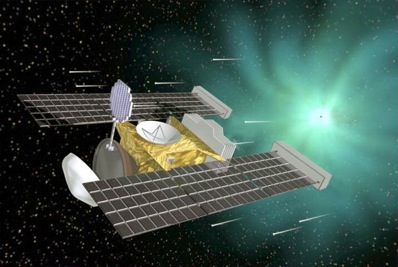
Building blocks of life
found in comet
DR EMILY BALDWIN
ASTRONOMY NOW
Posted: August 18, 2009


A fundamental building block of life, glycine, has been identified in the samples returned from comet Wild 2 by NASA's Stardust mission.
Glycine is an amino acid, which is used by living organisms to make proteins. Just as we arrange the 26 letters of the alphabet to create millions of words, life uses 20 amino acids to build millions of different proteins.
 As Stardust flew past comet Wild 2 it collected cometary grains in a grid of aerogel that was sealed in a capsule and returned to Earth. Image: NASA/JPL-Caltech.
As Stardust flew past comet Wild 2 it collected cometary grains in a grid of aerogel that was sealed in a capsule and returned to Earth. Image: NASA/JPL-Caltech.
"This is the first time an amino acid has been found in a comet," says Jamie Elsila of NASA’s Goddard Space Flight Center in Greenbelt, and lead author of a paper describing the results that has been accepted for publication in the Meteoritics and Planetary Science journal. "Our discovery supports the theory that some of life's ingredients formed in space and were delivered to Earth long ago by meteorite and comet impacts."
The Stardust spacecraft passed through the thick cloud of dust and gas surrounding comet Wild 2's icy nucleus in 2004, wielding a tennis racquet-like grid of a curious material known as aerogel. Aerogel is a sponge-like material that is more than 99 percent empty space, but as a result it gently captures the cometary grains without damaging them, essential when working with such pristine material. The samples were then sealed inside a stowage capsule which was returned to Earth in 2006.
 Tiny grains of cometary material were captured in the aerogel, leaving long tracks behind them. The grains were extracted back on Earth and analysed. Image: NASA/JPL-Caltech.
Tiny grains of cometary material were captured in the aerogel, leaving long tracks behind them. The grains were extracted back on Earth and analysed. Image: NASA/JPL-Caltech.
Comets have long been thought to hold the secrets of our Solar System's history, playing an essential role in delivering the building blocks of life to Earth. Elsila's team studied the aluminium foil that held the aerogel in place. "As gas molecules passed through the aerogel, some stuck to the foil," she says. "We spent two years testing and developing our equipment to make it accurate and sensitive enough to analyse such incredibly tiny samples."
Since glycine is used by terrestrial life, earlier detections of the amino acid in both the foil and aerogel had to be thoroughly analysed in order to rule out possible contamination. The new evaluation uses isotopic analysis to rule out that possibility. "We discovered that the Stardust-returned glycine has an extraterrestrial carbon isotope signature, indicating that it originated on the comet," confirms Elsila.
The team suggest that, based on their results, it is highly probably that the entire comet-exposed side of the Stardust sample collection grid is coated with glycine that formed in space.
"The discovery of glycine in a comet supports the idea that the fundamental building blocks of life are prevalent in space, and strengthens the argument that life in the Universe may be common rather than rare," concludes Carl Pilcher, Director of the NASA Astrobiology Institute which co-funded the research.
|



